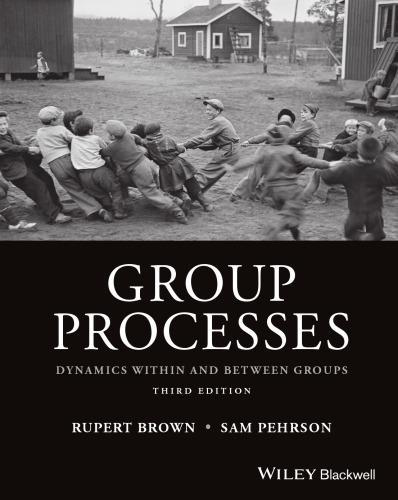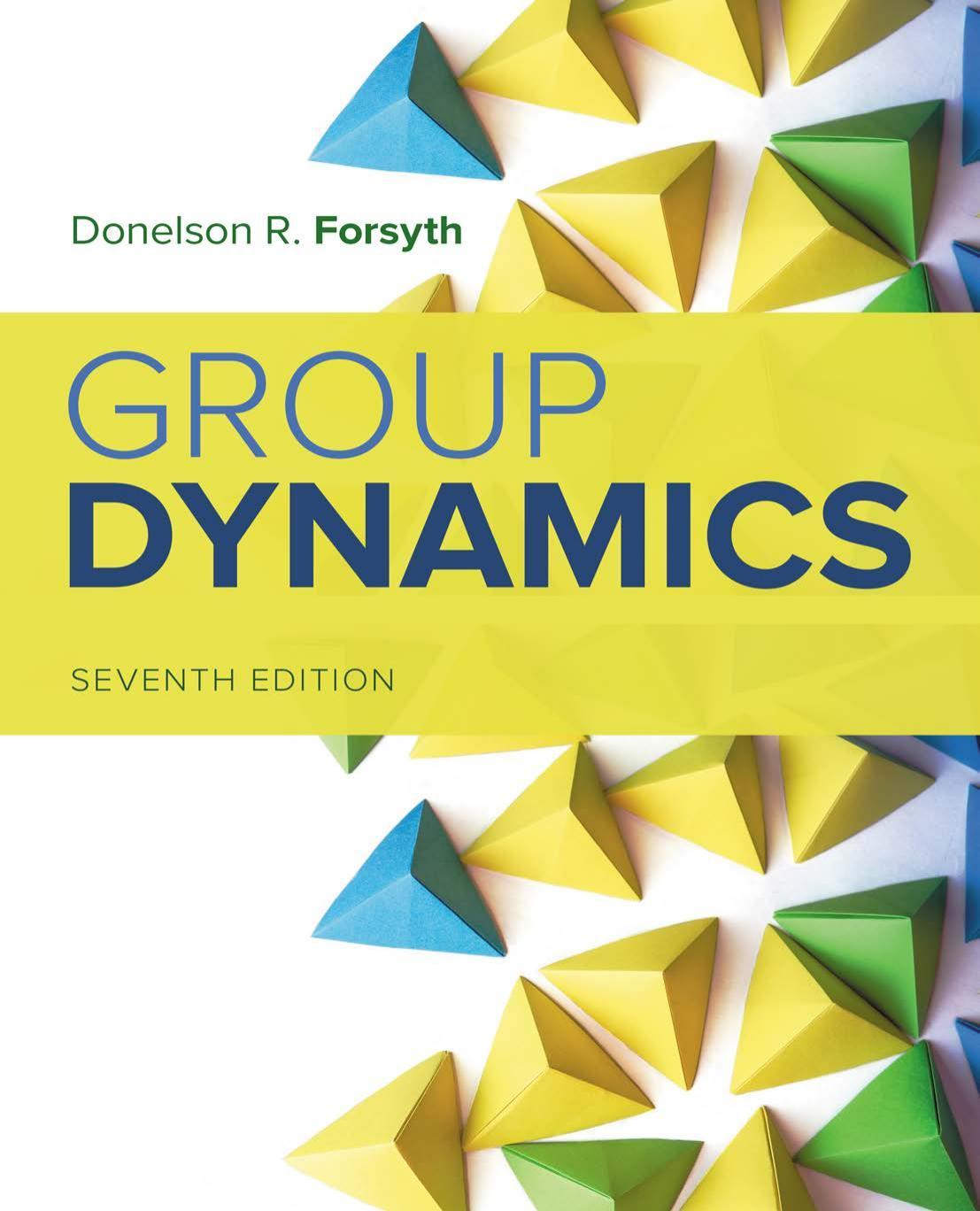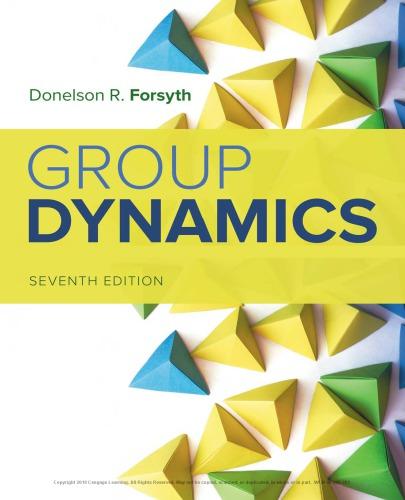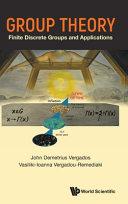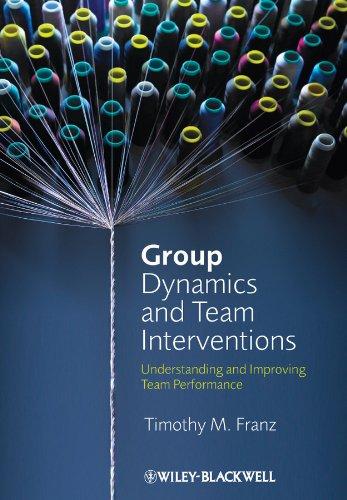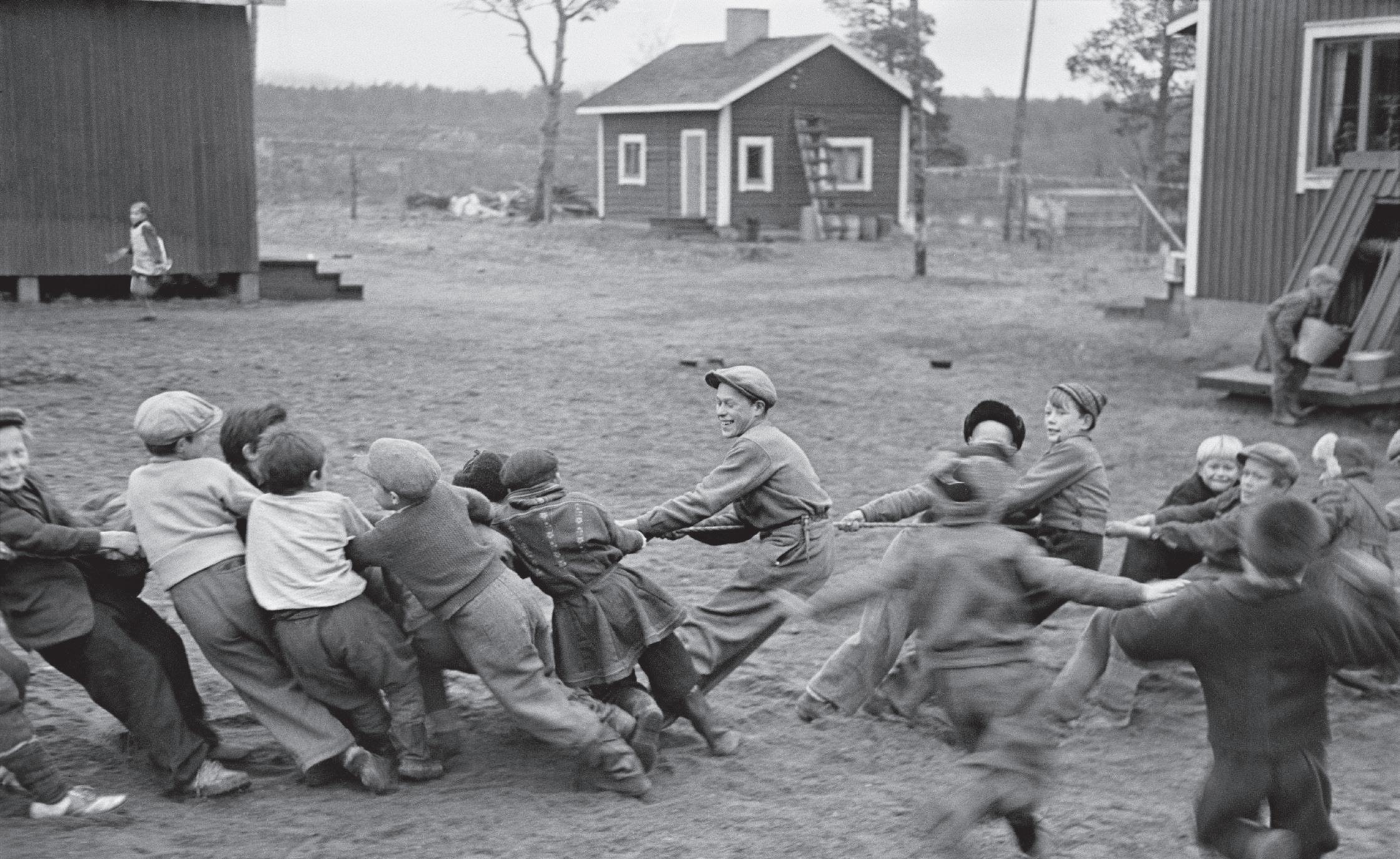GROUP PROCESSES
DYNAMICS WITHIN AND BETWEEN GROUPS
THIRD EDITION
RUPERT BROWN • SAM PEHRSON
GroupProcesses
GroupProcesses
DynamicswithinandBetweenGroups
RupertBrownandSamPehrson
ThirdEdition
Thiseditionfirstpublished2020
©2020JohnWiley&SonsInc.
EditionHistory
JohnWiley&SonsInc.(1e,1988and2e,1999)
Allrightsreserved.Nopartofthispublicationmaybereproduced,storedinaretrievalsystem,ortransmitted,inanyformorbyany means,electronic,mechanical,photocopying,recordingorotherwise,exceptaspermittedbylaw.Adviceonhowtoobtainpermissionto reusematerialfromthistitleisavailableat http://www.wiley.com/go/permissions
TherightofRupertBrownandSamuelPehrsontobeidentifiedastheauthorsofthisworkhasbeenassertedinaccordancewithlaw.
RegisteredOffice(s)
JohnWiley&Sons,Inc.,111RiverStreet,Hoboken,NJ07030,USA
EditorialOffice
JohnWiley&Sons,Inc.,111RiverStreet,Hoboken,NJ07030,USA
Fordetailsofourglobaleditorialoffices,customerservices,andmoreinformationaboutWileyproductsvisitusat www.wiley.com.
Wileyalsopublishesitsbooksinavarietyofelectronicformatsandbyprint-on-demand.Somecontentthatappearsinstandardprint versionsofthisbookmaynotbeavailableinotherformats.
LimitofLiability/DisclaimerofWarranty
Whilethepublisherandauthorshaveusedtheirbesteffortsinpreparingthiswork,theymakenorepresentationsorwarrantieswith respecttotheaccuracyorcompletenessofthecontentsofthisworkandspecificallydisclaimallwarranties,includingwithoutlimitation anyimpliedwarrantiesofmerchantabilityorfitnessforaparticularpurpose.Nowarrantymaybecreatedorextendedbysales representatives,writtensalesmaterialsorpromotionalstatementsforthiswork.Thefactthatanorganization,website,orproductis referredtointhisworkasacitationand/orpotentialsourceoffurtherinformationdoesnotmeanthatthepublisherandauthorsendorse theinformationorservicestheorganization,website,orproductmayprovideorrecommendationsitmaymake.Thisworkissoldwith theunderstandingthatthepublisherisnotengagedinrenderingprofessionalservices.Theadviceandstrategiescontainedhereinmay notbesuitableforyoursituation.Youshouldconsultwithaspecialistwhereappropriate.Further,readersshouldbeawarethatwebsites listedinthisworkmayhavechangedordisappearedbetweenwhenthisworkwaswrittenandwhenitisread.Neitherthepublishernor authorsshallbeliableforanylossofprofitoranyothercommercialdamages,includingbutnotlimitedtospecial,incidental, consequential,orotherdamages.
LibraryofCongressCataloging-in-PublicationData
9781118719299
Coverimage:WernerBischot/Magnumphotos
CoverdesignbyWiley
Setin10/12ptWarnockProbyAptaraInc.,NewDelhi,India
10987654321
Thisbookisdedicatedto: Issa,CeliaandLily(byRupert) and NinaandMirona(bySam)
Contents
Preface xi
1TheRealityofGroups 1
Definition 1
TheIndividual–GroupRelationship 2
TheInterpersonal-GroupContinuum 4
ThreeUnifyingThemes:SocialIdentity,SocialContextandSocialAction 6
Summary 11
FurtherReading 12
References 12
2GroupFormationandOtherElementaryGroupProcesses 15
Interdependence 15
AllintheSameBoat:InterdependenceofFate 16
WorkingwithOthers:TaskInterdependence 17
SocialCategorisation 19
FromIndividualstoaGroup:Entitativity 19
UsandThem:IntergroupDifferentiationandIntragroupAssimilation 22
When‘We’DeserveMorethan‘Them’:MinimalConditionsforIntergroup Discrimination 23
WhyDoThey(andWe)LookalltheSame?PerceivedIntragroupAssimilation (Homogeneity) 26
OnbeingSimilarorDifferentbutstillaGroup:Individuality,Interaction,and Entitativity 28
NotOnlyinOurHeads:ThePragmaticandRhetoricalUseofCategories 30
JoiningandInteractinginGroups:SomeElementaryGroupProcesses 31
JoiningGroups 31
FromGettingTogethertoStickingTogether:GroupCohesion 36 WhatGoesoninGroups?AchievingtheTaskandMaintainingRelationships 41
Summary 42
FurtherReading 43
References 43
3ReachingAgreementinGroups 51
TheAcquisitionandDevelopmentofGroupNorms 51
TheAcquisitionofGroupNorms 52
WhyPeopleneedNorms:IndividualFunctionsofGroupNorms 53
WhyGroupsneedNorms:SocialFunctionsofNorms 55
StabilityandChange 56
ThePoweroftheMajority 58
ThePervasivenessofConformity 59
WhydoPeopleConform? 61
StandingOutfromtheCrowd:OnbeingaDeviate 65
GoingtoExtremes:ReachingDecisionsinGroups 70
ExplanationsofGroupPolarisation 71
ConcludingRemarksonGroupPolarisation 76
Summary 77
FurtherReading 78
References 78
4InnovationandChangeinGroups 85
MinorityInfluence 85
Majority–MinorityInfluenceisaDynamicProcess 88
SocialCategorisationandMinorityInfluence:WhichGroupdoestheMinority Belongto? 91
TwoInfluenceProcessesorOne? 91
ConcludingComments 99
Leadership 100
CoercionandReward 100
Charisma 102
LeadershipStyles 105
InteractionofLeaderStyleandSituation 106
LeadersasCommittedGroupMembers 109
LeaderPrototypicality 110
ServingGroupInterests 112
‘Entrepreneurs’and‘Embedders’ofIdentity 113
Authority 115
Summary 116
FurtherReading 117
References 117
5TheEffectivenessofGroups 124
GroupProductivity 125
DoesthePresenceofOthersHelporHinderPerformance? 125
AreTwoHeads(orBodies)betterthanOne? 126
PotentialandActualProductivity:TheoriesofGroupDeficit 128
TwoHeads(orBodies)reallycanbebetterthanOne:TheBenefitsofWorking inGroups 133
GroupDecision-Making 140
ModelingGroupDecisions:SocialDecisionSchemesTheory 140
TheQualityofDecision-MakingProcess 142
GroupscanbeGoodforYou 146
Resilience 146
HealthandWell-being 150
Summary 152
FurtherReading 153
GroupProductivity 153
GroupDecision-Making 153
HealthandWell-beingBenefitsofGroups 153
References 154
6TheMoralityofGroups 161
AreGroupsreallymoreAggressivethanIndividuals?CollectiveAggressionandViolence 161
Deindividuation 162
ExperimentalEvidenceconcerningGroupsandAntisocialBehaviour 163
TheStanfordPrisonExperiment 166
HowGroupNormsshapetheNatureofCrowdViolence 169
IdentityTransformationandEmergenceofConflictinCrowds 171
OnlineAggression 172
GroupsandHelpingBehaviour 174
TheBystanderEffectanditsLimits 174
SolidaritywithintheGroup 176
HelpingtheOutgroup 182
Summary 184
FurtherReading 185
References 186
7ConflictandInequality 191
IntergroupRelationsandRealGroupInterests 192
TheDevelopmentofanIntergroupPerspective 192
TheSummerCampStudies 194
LessonsfromtheSummerCamps 196
ExtendingtheRealisticConflictApproach 197
‘RealWorld’Evidence 197
StereotypesandIntergroupRelations 198
Fear,Anger,Disgust,andOtherEmotions 201
TheOutgroupasSub-human 203
HierarchyandOppression 206
DivideandRule 206
ConsensualDiscrimination 207
AmbivalentSexism 208
OutgroupFavoritismandSystemJustification 210
SocialDominanceTheory 212
SocialDominanceOrientation 213
EvaluatingSocialDominanceTheory 216
IntegratingSDOandRWA 218
Summary 219
FurtherReading 220
References 220
8RebellionandSocialChange 227
AngryRejectionoftheStatusQuo 228
Anger 230
SocialIdentityTheory 235
IndividualMobility 236
SocialCreativity 239
ChangingtheDimensionofComparison 240
DownwardSocialComparison 242
RedefiningtheMeaningoftheDevaluedAttribute 242
SocialCompetition 243
WinningtheSolidarityoftheAdvantaged 243
ResentmentandBacklash 244
ExperiencingIllegitimatePrivilege 246
IntergroupContactandCollectiveAction 248
ConsequencesofCollectiveAction 250
Summary 252
FurtherReading 253
References 253
9BringingGroupsTogether 261
GettingtoKnowYou:IntergroupContactandPrejudiceReduction 262
ElaboratingtheContactHypothesis 263
HowtomakeContactWorkBetter:Decategorisation,Categorisation,or Recategorisation? 263
UnderstandinghowContactWorks:TheRoleofEmotion 268
IndirectFormsofContact:Extended,VicariousandImagined 270
IntergroupContactanditsCritics 275
“FromBothSidesNow”:TheImportanceofbothVictimandPerpetratorEmotions 279
Group-BasedEmotions:Guilt,Shame,Victimhood,andForgiveness 283
LivingTogetherorLivingApart:TheChallengesofDiversityandMulti-culturalism 287
AcculturationandWell-BeinginMinorityGroups 288
AcculturationandIntergroupRelations 291
Summary 294
FurtherReading 295
References 295
NameIndex 309
SubjectIndex 325
Preface
Thisbookhasalonghistory.Thirtyyearsago,oneofus(Rupert)waspresumptuousenoughtothink thathecouldwriteabookthatwouldintegratewhatwethenknewaboutsocialprocessesoperating withinsmallgroupswiththenewlyemergingfieldofintergrouprelations(Brown1988).Intheevent, thebookdidwellenoughtowarrantasecondeditionand12yearslater,itdulymadeitsappearance (Brown2000).Thatrevisionwasessentiallyanupdatingofthefirsteditiontotakeaccountofthehuge expansionofthefieldofgroupprocessesovertheprecedingdecade.However,itsbasicstructure–andmuchofitscontent–wasunchanged.
Afewmoreyearswentby,enoughtimetoconvincethepublishersthatathirdeditionwasnowdue. However,theideaofsimplyupdatingandenlargingthebookyetagainwasnotveryappealing.Not onlywasthetaskofcomingtogripswiththemushroomingliteratureongroupsratheradauntingone butalsothebookwasindangeroflosinganycoherenceitmightoncehavehadifthenewmaterial wassimplytobetackedontotheexistingstructure.Itbecameclearthat,ifathirdeditionwastobe written,itshouldnotbewrittenalone.
Withthatthoughtinmind,RupertapproachedhiscolleagueSamtojoinhimintacklingthenew edition.Theyquicklydecidedthataradicaloverhaulwasneeded.Inplaceoftherathereclectic approachadoptedintheearliereditions,theysoughttomakethebookmorethematicbyorganising itaroundthreeinter-linkedideas: SocialIdentity,SocialContext and SocialAction.
Groupsprovidepeoplewithasenseofwhotheyare–andwhotheyarenot–andmuchofwhat happenswithinandbetweengroupscanbeunderstoodasattemptsbypeopletoexpress,clarify,or defendtheir socialidentity.Butsocialidentitiesdonotdropfromtheetherfullyformed,norarethey immutableentities,fixedforlife.Theyemergefromparticular socialcontexts aspeoplereacttoand strivetomakesenseoftheirsocialworlds.Asthosecontextschange,sodoidentities.And,lastbut notleast,groupsareaprimaryvehicleof socialaction,bymeansofwhichpeopleoftenseektoachieve changeintheirenvironments.
Armedwiththesethreethemes,wesetaboutcompletelyreorganisingthebook.Mostofthechapter titlesarecompletelynewas,indeed,isthematerialtheycontain.So,althoughthetitleonthecover ofthebookisunchanged,whatiscontainedinthepageswithinisquitedifferent.Thisispartlyto giveexpressiontothosethreerecurringthemes,butitalsoreflectsourseveralandjointresearch preoccupations.Wehavesoughttodojusticetowhatweseeasthemostinterestingofcontemporary researchongroupsbut,indoingso,wehavetriedalsonottolosesightofclassiccontributions.We arenotbigfansofthe‘cultofthenew’;inourview,thereismuchinthehistoryofourdiscipline whichshouldberememberedandrespected(and,ofcourse,somewhichquiteproperlydeservesto beconsignedtooblivion).
Wealsowantedtooffera critical appraisaloftheoryandresearchongroups,ratherthanpresenting ablandoverview.So,onoccasion,wehavenothesitatedtosaywhywethinkatheoreticalperspective ismisguidedormyopic.Wehavealsotakenthelibertyofliberallyillustratingourdiscussionwith topicalexamplesdrawnfromtheworldsofsport,contemporarycultureandpolitics.Ourreaders maynotalwaysagreewithus,eitherinthepositionswetakeortheexampleswechoose,butwehope thattheywillatleastnotbebored.
ItiscustomarytoconcludeaPrefacewithsomeacknowledgements,andwedosogladlyhere. Wearebothindebtedtoourmanymentorsandcolleagues,pastandpresent.Mostnotably,andin alphabeticalorder:HectorCarvacho,ChrisCohrs,KayDeaux,JohnDrury,SamGaertner,Mirona Gheorghiu,RobertoGonzalez,MilesHewstone,NickHopkins,ColinLeach,KenMavor,Fergus Neville,SteveReicher,CliffordStevenson,HenriTajfel,NicoleTausch,VivVignolesandHanna Zagefka.
RupertBrown UniversityofSussex
SamPehrson UniversityofStAndrews April2019
References
Brown,R.(1988). GroupProcesses:DynamicsWithinandBetweenGroups.Oxford:Blackwell. Brown,R.(2000). GroupProcesses:DynamicsWithinandBetweenGroups,2e.Oxford:Blackwell.
TheRealityofGroups
Inthisbook,theexistenceofhumangroupsistakenforgranted:Wehaveassumedboththe realityofgroupsandsomeagreementoverwhatwemeanwhenweusetheword‘group.’But,infact, bothoftheseassumptionshavebeenthesubjectofconsiderablecontroversyinthehistoryofsocial psychology.Sincetheturnofthetwentiethcentury,therehavebeenheateddebatesnotjustabout whatgroupsarebutwhether,indeed,theyexistatall.Thischapterreturnstothosedebatesinorder toclarifysomeoftheissuesthatwillrecurthroughoutthebook.Webegin,conventionallyenough, withadefinitionofthegroupwhich,whileadmittedlyimprecise,willatleastprovideuswithafew signpoststoguideusthroughtheterrainahead.Thediscussionthenturnstothequestionoftherelationshipbetweentheindividualandthegroup:isthelatterreducibletotheformerorcantheyboth beconsideredasrealandinter-relatedentities?Ouranswertothisquestionstressestheimportance ofmakingadistinctionbetweenbehaviourwhenoneisactingasagroupmemberandbehaviour whenoneisactingasanindividual,andweoutlinesomeofthesocialpsychologicalprocessesthat underliethisdistinction.Akeyconcepthere,asindeeditwillbethroughoutthebook,isthatof social identity –people’ssenseofwhotheyareandtheimportanceofthatself-definitiontothem.Which socialidentitiesmattertopeopleandwhenisnotsomethingsetinstonehowever;itusuallydepends onthesituationstheyfindthemselvesinor,moregenerally,onthe socialcontext.Thisisthesecondconceptwhichwillrecurinthepagestofollow.Howweevaluateourgroupmembershipsand theirmeaningforusdependsonothergroupsinourenvironment,onsocialstructuralfactors(such asstatusandpower),andonwiderculturalfactors(suchasprevailingvaluesystems).Groupsare alsoimportantbecausetheyallowustoachieveourobjectives.Theyare,inotherwords,vehicles for socialaction, ofteninpursuitofsocialchange,andthisisthethirdthemeweemphasisein thisbook.
Definition
Eventhemostsuperficialsurveyoftextbooksongroupdynamicsquicklyrevealsawidediversityof meaningsassociatedwiththeword‘group’(CartwrightandZander1968).Forsometheorists,itis theexperienceofcommonfatewhichisthecriticalfactor(e.g.Campbell1958;Lewin1948;Rabbie andHorwitz1988).Thus,wecansaythatJewsinNaziEuropeconstitutedagroupbecauseoftheir common(andtragic)fateofstigmatisation,imprisonment,andextermination.Forotherthinkers, theexistenceofsomeformalorimplicitsocialstructure,usuallyintheformofstatusandrole GroupProcesses:DynamicswithinandBetweenGroups
relationships,iskey(e.g.SherifandSherif1969).Thefamilyisagoodexamplehere:wecanregard thefamilyasagroupbecauseitsmembershaveverywell-definedrelationshipswithoneanother (asparent,child,sibling,etc.),andtheserelationshipsusuallycarrywiththemclearpowerandstatus differences.However,athirdschoolofthoughtsuggeststhatthesestructuralrelationscomeabout becauseofastillmoreelementaryfeatureofgroups–thefactthattheyconsistofpeopleinface-tofaceinteractionwithoneanother(e.g.Bales1950).And,ofcourse,thisisacharacteristicofmanyof thegroupswebelongto–ourfamily,ourworkgroup,andahostofothers.
Thesecondandthirdtypesofdefinitiononlyreallyseemapplicabletosmallgroups(say,of20 membersorless)andwouldseemtoexcludelarge-scalesocialcategoriessuchasethnicgroups(as intheexampleoftheJewscitedpreviously),socialclass,ornationality.Andyet,asweshallseein laterchapters,theselargercategorymembershipscaninfluencepeople’sbehaviourjustassurelyas thesmallestface-to-facegroup.Thisproblemhasledsomewriterstoproposeamoresubjective definitionofthegroupintermsofpeople’sself-categorisations(Tajfel1981;Turner1982).According tothisview,agroupexistswhen,
twoormoreindividuals … perceivethemselvestobemembersofthesamesocialcategory. (Turner1982,p.15)
Thus,toreturntoourfirstexample,Jewsconstituteagroupbecauseasignificantnumberofpeople saytothemselves‘IamaJew’.Thevalueofthischaracterisationisitssimplicityanditsinclusiveness, andforthesereasons,itisthedefinitionweshalladoptinthisbook.Itisdifficulttoimagineagroup inwhichitsmembersdidnotatsomestagementallyclassifythemselvesasactuallybelongingtoit, andthedefinitionalsoencompassesthesmallestunit(adyad)aswellaslargersocialcategorieslike ethnicgroupsornations.
Thatsaid,itisworthnotingthat,formostpracticalpurposes,apurelysubjectivistconceptionofa groupmightmissanimportantfeatureofmostreal-worldgroups–thattheirexistenceistypically knowntoothers(Merton1957).Acentralthemeofthisbookisthatweneedtoconsidergroupsnot justintheirownrightbutalso inrelationto othergroups.Thus,althoughTurner’sdefinitionwill serveuswell,wewouldemphasisethatanadditionalfactorinmanygroupcontextsisalsotheextent towhichthatgroupisvisibletoorrecognisedbyothergroups.Thisbecomesimportantforsome marginalisedorstigmatisedgroups(e.g.sexualminorities)whomayfaceastruggletopersuadethe majoritytoaccepttheirexistence.
TheIndividual–GroupRelationship
Beforewecanbegininvestigatingthepropertiesofgroupsandtheireffects,thereisanimportant issuewhichmustbediscussedfirst.1 Thisconcernsthenatureoftherelationshipoftheindividual tothegroup–whatAllport(1962)describedassocialpsychology’s‘masterproblem’.Toputitatits simplest,thequestionisthis:istheremoretogroupsthanthesumoftheindividualsthatcomprise them?
1 Foramoredetaileddiscussionoftheissuescoveredinthisandthefollowingsection,seeBrownandTurner(1981).
Allporthimselfwasinnodoubtabouttheanswer.Inoneoftheearliestsocialpsychologytexts,he wrote
Thereisnopsychologyofgroupswhichisnotessentiallyandentirelyapsychologyof individuals.
(Allport1924,p.4)
Thethrustofthisoften-quotedremarkwasaimedatsomeofhiscontemporarieswhoheldthat groupshadsomementalpropertiesoverandabovetheconsciousnessoftheindividualswhichmake themup.Thus,LeBon(1896)andMcDougall(1920)bothtalkedofacrowdpossessinga‘group mind’whichledittoperformdeedswhichwouldbeconsideredunthinkablebytheindividualcrowd membersontheirown.Weshallreturntothetopicofcrowdbehaviourlaterinthebook(Chapter6), but,forthemoment,letusconsiderAllport’sargumentagainstthis‘groupmind’thesis.Allport’smain pointwasthatatermlikethe‘groupmind’couldnotbeindependentlyverified;itwasnotpossibleto touchorobservethisentitywhichwassupposedtopossessconsciousness, apartfromtheindividuals thatcomprisedit.
Inthis,hewassurelyright:totalkofagrouphavinga‘mindofitsown’doesseemtobeanunfortunatelapseintometaphysics.However,inrejectingtheideaofa‘groupmind’,Allportwantedto gofurtheranddisposeoftheconceptofthegroupaltogether.Althoughinhislaterwritings(e.g. Allport1962)heappearedtomodifyhispositionsomewhat,athearthewasstillastrictindividualist, believingthatgroupphenomenacouldultimatelybereducedtoindividualpsychologicalprocesses.
Thisreductionistviewhasnotgoneunchallenged,however.Othershavearguedthatarejection ofthe‘groupmind’fallacydoesnotimplythatweshouldabandonthestudyofgroupprocessesin theirownright.BeginningwithMead(1934),andfollowedbySherif(1936),Asch(1952),andLewin (1952),thesethinkersallinsistedontherealityofsocialgroups,believingthemtohaveuniquepropertieswhichemergeoutofthenetworkofrelationsbetweentheindividualmembers.Thisideawas nicelyexpressedbyAsch(1952)withachemicalanalogy.Asubstancelikewater,heargued,ismade upoftheelementshydrogenandoxygenandyethasverydifferentpropertiesfromeitherconstituent. Furthermore,thesesamemolecularconstituentswhendifferentlyorganisedorstructuredproduce substanceswithquitedifferentcharacteristics(e.g.ice,water,steam).Thus,inarealsense,thecompoundH2 Ois not thesimpleaggregateofitsconstituentsbutiscruciallyaffectedbytheirarrangement.So,too,withhumancompounds,orgroups:
Weneedawayofunderstandinggroupprocessthatretainstheprimerealityofindividualand group,thetwopermanentpolesofallsocialprocesses.Weneedtoseegroupforcesarisingout oftheactionsofindividualsandindividualswhoseactionsareafunctionofthegroupforces thattheythemselves(orothers)havebroughtintoexistence.
(Asch1952,p.251)
ForbothAschandSherif,therealityofgroupsemergesoutofpeople’scommonperceptionsof themselvesasmembersofthesamesocialunitandinvariousrelationstooneanotherwithinthatunit. Associatedwiththeseperceptionsarevariousgroupproductssuchasslogans,norms,andvalues,and these,too,canbecomeinternalisedandhenceservetoguidepeople’sbehaviour.Forthesereasons, itispossibletoacceptAllport’scritiqueofthe‘groupmind’,andyetdisagreewithhisconclusionthat
theconceptof‘group’hasnoplaceinarigoroussocialpsychology.EndorsingthewordsofSherif, thatpioneerofgrouppsychology,theviewwetakeinthisbookis
Wecannotdojusticetoeventsbyextrapolatinguncriticallyfromman’s[sic]feelings,attitudes, andbehaviourwhenheisinastateofisolationtohisbehaviourwhenactingasamemberof agroup.Beingamemberofagroupandbehavingasamemberofagrouphavepsychological consequences.Thereareconsequencesevenwhentheothermembersarenotimmediately present.
(Sherif1966,pp.8–9)
TheInterpersonal-GroupContinuum
Whatdoesitmeantosayapersonis‘actingasamemberofagroup’?Tajfel(1978a),animportanttheoristofgroupprocesses,alsostressedtheneedtodistinguishinterpersonalbehaviourfrom behaviouringroupsettings.Hesuggestedthreecriteriawhichhelpustomakethedistinction.The first,andmostcrucial,isthepresenceorabsenceofatleasttwoclearlyidentifiablesocialcategories, forexample,ablackandawhiteperson,manandwoman,andworkerandemployer.The second iswhetherthereisloworhighvariabilitybetweenpersonswithineachgroupintheirattitudesor behaviour.Groupbehaviouristypicallyhomogeneousoruniform,whileinterpersonalbehaviour showsarangeofindividualdifferences.ThecoordinatedsinginganddancingofjubilantIcelanders inReykjavikfollowingtheirvictoryoverEnglandinthe2016EuropeanFootballTournamentprovideagraphicillustrationofsuchbehaviouraluniformity(http://www.telegraph.co.uk/football/2016/ 06/28/incredible-scenes-in-reykjavik-as-iceland-knock-england-out-of-e/).ThosesameIcelanders, thedaybeforeorafter,wenttheirmultitudinousindividualways.The third iswhetherthereislowor highvariabilityinoneperson’sattitudesandbehaviourtowardsothergroupmembers.Doesthesame personreactsimilarlytoawiderangeofdifferentothers(asingroupstereotyping–seeChapter7) ordoesshe/heshowadifferentiatedresponsetothem?Inbrief,Tajfelsawallsocialbehaviouras lyingonacontinuumwhere,atoneend,theinteractionisseenasbeingdeterminedbythemembershipofvariousgroupsandrelationsbetweenthemwhile,attheother,itisdecidedmorebypersonal characteristicsandinterpersonalrelationships(BrownandTurner1981;Tajfel,1978a).
ThisdistinctionisbeautifullycaughtinascenefromKenLoach’s(1995)filmabouttheSpanish CivilWar,‘LandandFreedom’.Init,theEnglishheroofthestory,aCommunistPartymemberfrom Liverpool,hasbeenmakinglovewithaSpanishcomradethathemetwhilstfightingforP.O.U.M., oneoftheseveralgroupsalignedagainstFranco’sfascists.Justaftertheirmomentsofintimacyhe revealsthatheisleavingP.O.U.M.tojointhecommunist-ledInternationalBrigade.Instantly,her attitudetowardshimchanges,andsheleaveswithhardlyanotherword.Thediscoverythathewas abandoningP.O.U.M.foranotherparty,agroupshesawasopposedtothecauseshewasstruggling for,transformedtheirinterpersonalrelationshipastwoloversintoanintergrouponeasmembersof rivalpoliticalfactions.
Asamoreformalillustrationofthisinterpersonal-groupdistinction,letusconsiderthefindings fromanearlyexperimentongenderstereotyping(Doiseetal.1978).Here,childrenwereaskedto lookataseriesofphotographsofboysfollowedbyasimilarsetofpicturesofgirls(orviceversa). Foreachpicture,theyhadtocheckoffvarioustraitadjectiveswhichtheythoughtappliedtotheboy orgirlinquestion.Inthe‘experimental’condition,thechildrenweremadeawareofthetwosetsof
photographsfromtheoutset.Inthe‘control’condition,theywerenotawareofthesecondsetuntil theyhadcompletedthefirst.Inotherwords,wemightassumethatforthe‘control’children,the secondsetofpicturesarrivedsomewhatasasurprise,andhencepresumablygenderwaslesssalient forthemwhilsttheyweremakingtheirinitialjudgements.Wecould,therefore,classifythissecondconditionasbeingsomewhatmore‘interpersonal’innatureascomparedtotheformermore group-orientedcondition.Thejudgementsmadebythechildrenseemedtobeconsistentwiththis assumption.Inthe‘experimental’condition,thejudgementswereclearlypatternedalonggender lines:themaleandfemalephotographsreceivedfewtraitsincommon,and within eachset,there weremoreidenticaltraitschecked.Inthe‘control’condition,incontrast,thechildrenseemedtopay moreattentiontotheidiosyncraticfeaturesofeachpicture:therewasmuchlessperceiveddifferentiationbetweentheboysandgirlsandlessperceivedsimilaritywithineachcategory.
Beforeweleavethisissue,therearethreefurtherpointstobemade.Thefirstisthatwhatdistinguishesinterpersonalandgroupbehaviourisnotprimarilythenumberofpeopleinvolved.Thus, wherepoliceandstrikersfaceeachotheracrossapicketline,whatplacesthatinteractiontowardsthe ‘group’poleisnotnecessarilythefactthatmanypeopleareinvolved.Whatindicatesitasaninstance ofgroupbehaviouristheuniformityoftheirbehaviour,whichsuggeststhattheparticipantsappearto beinteracting intermsof theirgroupmembershipsratherthantheirdistinctivepersonalcharacteristics.Thisisimportantbecausesocialencountersarefrequentlyratherambiguoustodefine.Take,for instance,aninteractionbetweenjusttwopeoplewhohappentobelongtodifferentsocialcategories (e.g.amanandawoman).Isthisencounteraninterpersonalonebecausejusttwopeopleareinvolved orisitagroup-basedinteractionbecauseofthecategorydifference?Fromthebarestdescriptionwe havejustgiven,itisnotpossibletosay.Whatwouldbeneededbeforewecouldcharacterisethissituationwouldbeaclosestudyofthecontentoftheinteractionbetweenthem.Ifitappearedbyword andgesturethattheparticipantswereorientatingtowardseachotherinarelativelypredictableand sex-stereotypicfashion,thenthiswouldindicateaninstanceofgroupbehaviour.Intheabsenceof this,theidiosyncraticnatureoftheinteractionwouldsuggestamoreinterpersonalencounter.
Thisraisesthesecondpointthattheinterpersonal-groupdistinctionisbasedonacontinuous dimensionandisnotaneither/ordichotomy.Mostsocialsituationswillcontainelementsofboth interpersonalandgroupbehaviours.Afterall,peopleentereventhemostgroup-basedinteraction withauniqueprehistoryandsetofpersonaldispositionsandeventhemostintimateexchange betweentwoloverswillcontainsomegroup-stereotypicfeatures.Whilethisnecessarilycomplicates acompleteanalysisofanyparticularsituation,sincebothsortsofprocesseswillbeatwork,itdoes notobviatetheneedforaclearunderstandingofthedifferencebetweenthesesortsofprocessesand howtheybothinteract.
Thethirdandmostimportantpointisthat,ifweacceptthisdifference,thenitfollowsthatwe mayneedratherdifferentkindsoftheoriestounderstandgroupprocessthanwetypicallyuseto explaininterpersonalbehaviour.2 Theoriesaboutinterpersonalbehaviourtypicallyinvokeeitheror bothoftwokindsofprocess.Oneistheoperationofsomefactorwithintheindividual–forinstance, theperson’spersonalitymake-up,cognitivestyle,oremotionalstate.Theotheristhenatureofthe relationshipbetweenindividuals–forinstance,whethertheylikeordislikeeachotherorwhether
2 Notethatinsuggestingthatwemayneedotherkindsoftheorieswearenotdenyingthatthosecouldstillaimtoexplain thebehaviourofindividuals.Indeed,withAllport,webelievethatasocialpsychologyofgroupprocessesshouldbemainly concernedwiththebehaviourofindividuals.Thedifferenceisthatweareconcernedwithindividuals asgroupmembers andnotwithindividuals asindividuals
theyhavesimilarattitudes.Inotherwords,variationsinpeople’sbehaviourareexplainedeitherby differencesbetweenthepeoplethemselvesorbydifferencesinthepersonalrelationsbetweenthem. Butoncewearedealingwithgroupsituations,suchexplanationsarelessusefulbecausetwoofthekey characteristicsofgroupsituationshavetodowith uniformities betweenindividualsratherthantheir differences.Onefootballfanmaytauntanother,particularlyiftheyarewearingdifferentcoloured scarves,inignoranceof,ordespite,manysimilaritiesofattitude,socio-economicstatus,physical appearanceandpersonality.Andifthereareathousandsuchsupporterstogether,themultiplicityof personalitytypesandthecomplexityofinterpersonalrelationsbothwithineachgroupandbetween thegroupsbecomeenormous,and yet theirbehaviourisoftenstrikinglyuniform.Theconclusion mustbe,therefore,asoneofuswroteelsewhere,
thatthedirectextrapolationoftheoriesaboutinterpersonalbehaviourtogroupcontextsis inherentlyfraughtwithdifficultiesandthusthatalternativetheories,relatingspecificallyto groupbehaviour,arenecessary.
(BrownandTurner1981,p.46)
Oneofthepurposesofthisbookistoexaminethoseothertheoriesandassesstheirutilityand relevanceforunderstandinggroupphenomena.
ThreeUnifyingThemes:SocialIdentity,SocialContextandSocialAction
Intheprevioussection,wenotedhowpeople’sbehaviourcanchangedramaticallyandsuddenlyonce groupscometotheforepsychologically.Whatunderliesthis‘switching’process?Tajfel(1978a),followedbyTurner(1982),suggestedthatitisgovernedbychangesinthewaypeopleseethemselves, intheirself-concepts.Accordingtothesetheorists,theself-conceptcanbeconsideredashavingtwo components:personalidentityandsocialidentity.Personalidentityreferstoself-perceptionsinpersonaloridiosyncraticterms–forexample,‘Iamanoutgoingperson’or‘Iamaloverofbluesmusic’. Socialidentity,ontheotherhand,denotesself-definitionsintermsofcategorymemberships–for example,‘IamaLiverpoolsupporter’or‘Iamaman’.Itwasthissecondconceptionofidentitythat formedtheheartofSocialIdentityTheory(SIT),TajfelandTurner’senduringcontributiontoour understandingofgroupprocesses(Tajfel, 1978b;TajfelandTurner1979,1986).Becausewe,too, consider socialidentity tobesuchanimportantconcept,wehavechosentouseitasoneofthree unifyingthemesofthisbook.
Tajfeldefinedsocialidentitythus
…that partofanindividual’sself-conceptwhichderivesfromhis3 (sic)knowledgeofhis membershipofasocialgroup(orgroups)togetherwiththevalueandemotionalsignificance attachedtothatmembership.
(Tajfel 1978b,p.63;emphasisinoriginal)
Itisworthmakingafewcommentsaboutthisdefinitionbeforeconsideringthetheorywhichgrew outofit.
3 Ofcourse,womencanhaveasocialidentitytoo!
Note, first, thatmanygroupmembershipscan,inprinciple,contributetooursocialidentity althoughprobablynotallwilldososimultaneously.Indifferentsituations,differentidentitiescome intoplayor,aswewouldsaymoreformally,become psychologicallysalient.Whatdeterminesidentity salience?Onefactorisone’sstatusasamemberofanumericalminorityormajority.Whilstwriting thischapter,oneofuswasenjoyingafewmonthssabbaticalinItaly.Duringthatsojourn,hisappearanceandhisexecrablyaccentedItalianmarkedouthisminoritystatuswhereverhewent,witha resultingmuchenhancedself-consciousnessofhisEnglishness.Researchconfirmsthatthiswasnot anidiosyncraticimpression;generally,minoritiestendtohaveastrongersenseoftheirgroupidentity thanmajorities(McGuireetal.1978;SimonandBrown1987;Verkuyten2005).
However,relativenumerosityisnottheonlydeterminantofidentitysalience.Frequently,itwill befeaturesofthesituationitselfwhichwillevokeoneidentityratherthananother.Considerthe followingevents,alloccurringwithin24hoursofeachotherinJune2016:BBCTVairedadebateon theforthcomingreferendumaboutwhetherBritainshouldremaininorleavetheEuropeanUnion (EU)(15June2016);theUniversityandCollegeUnion,themaintradeunionrepresentingacademics, calledastrikeinsupportofitspayclaim(15June2016);EnglandplayedWalesintheEuropean footballtournament(16June2016).Observingeachoftheseeventsevokedthreedifferentidentities ofoneoftheauthorsofthisbook(Rupert):inthefirst,asa European (fearfulofBritain’spossibleexit fromtheEU4 );inthesecond,asa tradeunionist (angryathisemployer’scontinuedmiserlytreatment ofitsstaff);inthethird,asan Englishman (everhopefulthatwemightonedayactuallywinafootball tournament5 ).Inshort,itis‘horsesforcourses’asfarasidentitysalienceisconcerned–different contexts,differentidentities(Oakesetal.1994;Reicheretal.2010).
Althoughoursocialidentitiesaresituationallylabile,itisalsotruethat,forsomepeople,certain identitiesmaybechronicallysalient.Thus,forhighlyracistpeople,theirethnicidentitiesarelikelyto bealwaysreadilyaccessible,apermanent(ifmyopic)lensthroughwhichtheyviewandinterpretthe world.Or,totakeanotherexample,apersonbelongingtoastigmatisedgroup,orwhohasastrong concernaboutinjusticefacedbyaparticulargroup,mightalsohaveachronicallyaccessiblesocial identitybasedonthis,forquitedifferentreasons.Thischronicaccessibilitymaybeduetoanynumberofpersonal(biographical)reasons.Nevertheless,howeverdeeplyembeddedaparticularidentity mightbe,itisunlikelytopreventotheridentitiesbeingactivatedifagivensituationdemandsit.To pursueouraboveanecdotalexampleofgroupsaliencealittlefurther,theotherauthor(Sam)shares allthreerelevantgroupmemberships(European,tradeunionistandEnglish).TheEUreferendum andtheunion’scalltostrikehadsimilareffectsonthesalienceofhissocialidentities.However,the footballmatchthatrousedsuchenthusiasticpatriotisminRupertwasmetwithnear-totalindifferencebySam,hisfellowingroupmember.Thishighlightsafurtherwayinwhichsituationsinteract withindividualdifferences:oneofushasanEnglishidentitycloselytiedtofootballwhilsttheother doesnot.Indeed,manyofthelarge-scalecomplexcollectiveidentitiesthataresopotentinmost societies–ethnicity,religion,nationality,classandgender–canbeunderstoodanddefinedquite differentlybymembersofthesamegroup,apointthatwewillreturntothroughoutthisbook.
A second pointisthatwhatmakesagivenaspectofidentitysocialratherthanapersonaldepends onwhetheritservestodefineusincollectiveratherthanindividualtermsinanyspecificsituation. Itisnotthatsomeaspectsofourselvesalwaysfunctionasoursocialidentities,andothersarealways
4 Afearwhichprovedwell-founded.On23June,2016,amajorityofBritishvotersinthereferendumvotedtoleavetheEU.
5 Ahope,alas,dashedoncemore.On27June,2016,Englandwereeliminatedfromthetournament,havingbeenbeaten 2-1byIceland.
partofpersonalidentity.Featuresofourselvesthatweusuallythinkofaspartofourindividuality couldverywellbecomesocialidentitiesundertherightconditions.Forexample,bothauthorsofthis bookwearglasses.Whilstthisisanattributethatwepresumablysharewithsomereadersandnot others,noneofusislikelyundernormalcircumstancestothinkofitasagroupmembership.Rather, incombinationwithnumerousothersimilaritiesanddifferencesbetweenus,wearingglasses–to theextentthatweeventhinkaboutitatall–issimplyonepartofourindividuality.Yet,asSimon (1997)pointsout,itispossibletoimaginehypotheticalscenariosinwhichthiswouldbedifferent. Anoppressivegovernmentinsomeimagined(hopefullyveryunlikely!)dystopiamightpersecute glasses-wearersaspartofaeugenicprojecttoeradicateimperfectvisionfromthepopulation,for instance.Undersuchcircumstances,whetheronewearsglassesornotcouldbecomeacrucialgroup membershipthatbindsuspowerfullytogether(seealso,PehrsonandReicher2014).Thepointhereis thatthedistinctionbetweensocialandpersonalidentitiesdoesnotdescribetwoinherentlydifferent kindsofattributes,butratherdifferentwaysthatattributescanfunctionincontext:eitherdefining usasuniqueindividualsorbringingtotheforeourcommonalitywithotherswhilstsimultaneously distinguishingusasagroupfromthosewhodonotsharethatattribute.
A third observationaboutTajfel’sdefinitionofsocialidentityisthatitismulti-faceted–ithas cognitive(‘knowledge’),evaluative(‘value’),andaffective(‘emotionalsignificance’)components.So, whentravellingabroad,wemaybecomemoreawareofournationality,wewillusuallyhavesome senseofourcountry’sstandingrelativetoothercountries,andwemayhavefeelingstowardsorabout ourcountry,especiallyifithasdonesomethingweareproudorashamedof.Takentogether,these threecomponentscompriseournationalidentity.Althoughmuchoftheearlyresearchinspiredby (SIT)focussedmainlyonthefirsttwoelements,subsequentworkturneditsattentiontotheemotionalaspectsofsocialidentity(e.g.Mackieetal.2009;Smith1993;seeChapter9).Andmeasurement attemptshavealsotypicallyincorporatedallthreeelementsintoscalesofgroupidentification(Brown etal.1986;Ellemersetal.1999;Leachetal.2008).
Armedwiththeconceptofsocialidentity,TajfelandTurner(1979,1986)soughttospelloutits implicationsforgroupandintergroupbehaviourintheirfamousSIT.Thetheoryrestsonthreesimple assumptions:(i)ingeneral,peopleprefertoviewthemselvespositivelyratherthannegatively–they seektohaveapositiveself-concept;(ii)since,aswehavejustnoted,people’sself-conceptsareoften boundupwiththeirgroupmemberships,itfollowsthattheywillalsoseektohaveapositivesocial identity;(iii)theevaluationofthosegroupmemberships,thosesocialidentities,isessentiallycomparative–ourowngroupsarealwaysregardedassimilarto,orbetter(orworse)thansomeother groups.Fromthesethreeideas,TajfelandTurnerthendrewouttwoimplications:givenageneral preferenceforapositiveidentity,peoplewillbemotivatedtoseekoutwaystheiringroupscanbe seenasdifferentfromandbetterthanoutgroups,theso-calledsearchfor‘positivedistinctiveness’ (TajfelandTurner1979,p.44);whenthatsearchisthwarted,thatis,wherepeople’ssocialidentityis notpositive,theywilltakestepstoremedythesituation.Thesemaymeanabandoningtheiringroup foranotherortheycouldinvolvecreativelydevelopingnewformsofintergroupcomparisonwhich wouldshowtheingroupinamorefavourablelight.
These,then,arethebarebonesofSIT.Inlaterchapters,wewillputsomefleshonthatskeletonas wediscussthetheory’simplicationsfortopicsasvariedasgroupformation(Chapter2),socialinfluence(Chapters3and4),leadership(Chapter4),groupeffectiveness(Chapter5),collectivebehaviour (Chapters6and8),andintergroupreconciliation(Chapter9).Fornow,though,letusjustunderline somefeaturesofthe‘socialidentityapproach,’asReicheretal.(2010)havedubbedit.Doingsowill allowustointroducetheotherunifyingthemesofthebook.
Thefirstpointisanobviousbutimportantone.Withthedefinitionofsocialidentityprovidedby Tajfel(1978b),itfollowsthat,givensomedegreeofidentification,whateverhappenstothegroup alsohappenstoitsmembers.Itssuccessesbecometheirsuccesses,itstravailstheirtravails.Thiswas illustratedinanearlystudybyCialdinietal.(1976).Theyobservedcollegestudentsonthedaysfollowinginter-collegiatefootballgames.Iftheircollegehadwon,collegescarvesandclothingwere muchmorevisiblearoundcampusthanifithadlost(seealso,Snyderetal.(1986)foranexperimentaldemonstrationofthesamephenomenon).Asalesstrivialexample,considerthereactionsofthe Lesbian,Gay,Bisexual,andTransgender(LGBT)communityintheUSAfollowingthehorrificmurderof50peopleataGaynight-clubinOrlando,FloridainJune2016(https://www.theguardian.com/ world/live/2016/jun/12/florida-nightclub-shooting-terrorism-suspect-updates).Iftheresultsof somerecentresearchofoursaretobebelieved,itisverylikelythattheLGBTcommunityfelta mixofthreat,anger,andfearonlearningofsuchahorrifichomophobicattack(Patersonetal.2018). Eventhough(thankfully)thevastmajorityofAmericanLGBTpeoplewerenotdirectlyaffectedby themassacre,theirsharedLGBTidentitywillhavemeantthattheyfeltsuchemotionsvicariously. Thesecondpointwewishtomakeistore-emphasisewhatwewroteearlierabouttheimportance ofthe socialcontext forevokingparticularsocialidentities.Now,giventhesnap-shotofSITthat wehavejustprovided,itisapparentthatcontextualvariablesareimportantinmorewaysthanjust makingthisorthatidentitysalient;theyarealsocrucialbecausetheyprovidetheparameterswithin whichthosesocialidentitiesareevaluatedandenacted.Ifourgroupoccupiesasomewhatprivileged (ordeprived)positioninsociety,thishasanimpactonhowweevaluateitandhowwerespondto thatintergroupevaluation.Weexaminesomeoftheimplicationsofsuchsocial(dis)advantagein Chapter8.
Inthesenseinwhichwehavejustusedit,‘context’referstostructuresofgroupinequalitythatare pervasiveinmostsocieties(SidaniusandPratto1999).But,thereisanother,morecultural,interpretationof‘context’.Itisself-evidentthatallgroupandintergroupprocessesoccurwithinsystemsof culturalvaluesandnorms(Smithetal.2013).Thiswillsometimesmeanthattheoperationofthose processestakesaverydifferentformindifferentcultures.6 Letusexamineonelargecross-cultural studyconductedin18differentcountriesbywayofanillustrationofthispoint(Beckeretal.2012).
Thegoalofthisresearchwastoinvestigatethegeneralityofthemotivetoattainadistinctiveidentity.Thisisobviouslyrelevanttothecurrentdiscussionsince,aswenotedpreviously,SITholdsthat thismotiveiscentraltounderstandingintergrouprelations.Theparticipants(all5158ofthem!)were firstaskedtowritedowntenanswerstothequestion,‘Whoareyou?’(KuhnandMcPartland1954). Then,foreachoftheiranswers,theywereaskedhowimportantorcentralitwastotheiridentityand howhappytheyfeltabouteachone.Thencamefourdistinctivenessquestionswhere,foreachoftheir 10answers,participantshadtoindicatehowmucheachdistinguishedthemfromothers(generaldistinctiveness),gavethemaparticularroleorpositioninrelationtoothers(positiondistinctiveness), madethemadifferentkindofpersonfromothers(difference),andcreatedaboundarybetweenthemselvesandothers(separateness).Finally,thereweresomequestionsabouttheendorsementofcertain culturalvalues(e.g.individualism–collectivism,Hofstede1980.Therewerethreemainfindingsfrom thisstudy:first,distinctivenesswasconsistentlyregardedasanimportantfacetofpeople’sidentitiesacrossthewholesample,suggestingthatitis,indeed,afairlygeneralmotive;second,though,
6 Notnecessarily,ofcourse.Wedonotruleout apriori thepossibilityofsomequasi-universalprocesses.However,wedo notbelieveitiswisetoadoptthelatterhypothesisbydefault.
itseemedtobesomewhatstrongermotiveincountriesthatwere,onaverage,morecollectivisticin nature;andthird,thekindofdistinctivenessalsodependedonculture.Inmorecollectivisticcultures,itseemedtobemoreimportanttoestablishone’sdistinctivenessviatypesofsocialrolesor positions,whileinmoreindividualisticsocieties,thedistinctivenesswasderivedmorefromdifferencesbetweenpeople.Thus,althoughaneedfordistinctivenessisimportant,assurmisedbySIT, thewaysthatdistinctivenessisestablishedisquitecontextdependent.
ThereisonetechnicalaspectofthatstudybyBeckeretal.(2012)thatisworthmentioningbecause itisagoodexampleofhowgroupresearcherscanincorporatethesocialcontextintotheirresearch. Bydefinition,‘socialcontext’isnotanindividuallevelvariable.Itreferstosomefeaturesofthe situation–forexample,class-roomnorms,organisationalclimate,culturalvalues–atasupraindividuallevel.Tostudysuchcontextualvariablesproperlyitisoftenusefultouseastatisticaltechniqueknownasmulti-levelmodelling(e.g.Hox2002;Pettigrew2006).Thistechniqueallowsoneto investigatewhethersomeparticularprocessatanindividualpsychologicallevelisaffectedbyavariableatacontextuallevel(orlevels).Occasionally,suchmulti-levelanalysisyieldscounter-intuitive results.
Onesuchsurprisingdiscoverywasmadebyusinsomeresearchintotherelationshipbetween strengthofnationalidentificationandanti-immigrantprejudice(Pehrsonetal.2009).FromastraightforwardreadingofSIT,onemightpredictthatthisrelationshipshouldbepositive:themoreimportantacountryistoaperson,themores/hemightwanttodifferentiateher/hiscountryfrom‘foreigners’–thatis,showprejudice.Weexaminedthecorrelationbetweennationalidentificationand prejudiceinaverylargecross-nationalsurvey(over37000respondentsfrom31differentcountries). Sureenough,theoverallcorrelationatanindividuallevelwas(weakly)positive(median r = +0.13).7 However,thataveragecorrelationdisguisedmuchinter-countryvariation(from 0.06to+0.37,with 12countriesactuallyshowingeffectivelyazerocorrelation).Furtherinvestigationrevealedsomeof thereasonsforthatvariability.Itturnedoutthat,incountrieswherepeoplebelievedthatnationalitywasbasedonspeakingacommonlanguage,theidentification-prejudicepositivecorrelationwas stronger;wherepeoplebelieveditwasbasedonacquiringcitizenship,thecorrelationwasweaker. Thisisaclassicexampleofhowarelationshipatanindividuallevelcanbeaffectedbyafactorata macro(group)level.Weshallseeotherexamplesofsuchmulti-levelresearchinthechaptersthat follow.
Beforeweconcludethischapter,thereisonefinalpointtomakeaboutthesocialidentityapproach weareadoptinginthisbook.Thisisthatgroupprocessesarenotjustthingsthathappentousas groupmembers(althoughtheyoftendo,asweshallsee),buttheyarealsofrequentlythemeansby whichweactontheworldtochangeit.Inotherwords,groups,throughtheidentitiestheyconfer, providethebasisforsocialaction.Thispotentialforhumanagency(andchange)stemsfromthecore ideaofSITanditssuccessor,SelfCategorisationTheory(Turneretal.1987),thatincertainsituations, theattributesofthegroupbecomeinternalisedbyitsmembers.Thevalues,norms,andgoalsofthe groupbecomethevalues,norms,andgoalsofall(oratleastmost)ofthegroupmembers.Inthisway, theybecomecapableofunified–andhencemoreeffective–collectiveaction.
Theimportanceofthisthirdsocialactionthemewillbereadilyapparentinthechapterswhich follow.Inourdiscussionofinnovationandchangeingroups(Chapter4),wewillshowhowsocial
7 Interestingly,thesamecorrelationatacountrylevel(takingtheaveragelevelofidentificationineachcountryandthe averagelevelofprejudice)was(moderately)negative( 0.41).Althoughslightlycounterintuitive,itisstatisticallyperfectly possibleforthesignofacorrelationatonelevelofanalysistoreverseatadifferentlevel.
influenceisnotalwaysaboutcoercingpeopletobehaveuniformly;itisalsoamechanismtobring aboutchange.Thesameargumentreappearsstillmoreforciblywhenwediscussleadership(Chapter4),whereakeyissueishowleaderscanbecomeeffective‘entrepreneursofidentity’,thebetterto realiseagroup’sobjectives(Haslametal.2011).ItalsosurfacesinChapter5whereweshowhow, inperformancesettings,groupscansometimessurpasstheaggregateofindividualcapacities,perhapsbecausetheinternalisationofgroupgoalsbythegroupmembersprovidesmotivationaladded value.Andthelinkbetweensocialactionandchangetakescentrestageinourdiscussionofcollectivebehaviour(Chapter6)andrebellionandsocialchange(Chapter8).Therecurringthemeofthese chaptersistoshowhowsocialidentityprocessesareimplicatedinanyproperunderstandingofsocial movements.
Insummary,then,thethreecentralargumentsofthisbookare,first,thatwecannotunderstand howpeoplebehaveingroups,bothtowardsfellowgroupmembersandtowardsthoseinother groups,withouttheconceptof socialidentity –themanifoldwaysinwhichpeopledefinethemselves ingrouptermsandthenattachvalueandemotiontothoseself-categorisations.Second,suchsocial identityprocessesarealwaysdependentonthe socialcontext inwhichpeople,andthegroupsthey belongto,findthemselves.Suchcontextualvariablesmayoperateatmanydifferentlevels,fromthe micro-contextofparticularsocialenvironmentstothemacro-contextofsocietalstructuresandvalue systems.Third,groupsprovidetheprincipalvehicleforpeople’s socialactions toeffectchangeintheir worlds.Thisisnottodenyotherformsofhumanagencytobringaboutpersonalorinterpersonal changebuttoemphasisetheimportanceofcollectiveactiontoachievelargerscalesocialchange.
Summary
1. Agrouphasvariouslybeendefinedastwoormorepeopleexperiencingsomecommonfate or coexistingwithinsomesocialstructure or interactingonaface-to-facebasis.Thesimplerand morecomprehensivedefinitionadoptedhereistwoormorepeoplepossessingacommonsocial identity.
2. Somehavearguedthatgroupscanbereducedtothesimpleaggregateofthemembersthatcomprisethem.However,justaschemicalcompoundsmaydifferradicallyfromtheirconstituentelementsso,too,peopleingroupsmayactverydifferentlyfromhowtheybehavewhentheyarein isolation.
3. Itispossibletoconceiveofallsocialbehaviouraslyingonacontinuumfrominterpersonalsettings togroupsettings.Thekeyfeaturesofthelatterarethattwoormoresocialcategoriescanbe identified,behaviourofgroupmembersistypicallyratheruniform,andindividuals’treatmentof othersbecomesstereotyped.
4. Groupsareimportantpsychologicallybecausetheyprovidepeoplewithsocialidentities.Thisis thecentralpremiseofSIT,atheoreticalapproachwhichhasmanyramificationsforgroupand intergroupprocesses.AccordingtoSIT,socialidentityhascognitive,evaluative,andemotional components:itcomprisesourknowledgeofourgroupmembershipsandtheirassociatedevaluativeandaffectivesignificanceforus.Whichidentitiesareimportantforusatanymomentdepends stronglyoncontextualfactors.
5. SITholdsthatpeoplegenerallypreferapositivesocialidentityandwillworkhardtosustainthis. Agroup’spositivity(ornegativity)ismostoftenestablishedviacomparisonswithothergroups. Thisleadspeopletoseekpositivedistinctivenessintheirdealingswithothergroups.
6. Threerecurringthemesinthisbookaresocialidentity(asjustdescribed),socialcontext(the micro-andmacro-featuresoftheenvironmentsinwhichgroupsoperate),andsocialaction (groupsarevehiclesforachievingourgoalsandbringingaboutsocialchange).
FurtherReading
Asch,S.E.(1952). SocialPsychology,chapter9.
Brown,R.J.andTurner,J.C.(1981).Interpersonalandintergroupbehaviour.In: IntergroupBehaviour (eds.J.C.TurnerandH.Giles).
Reicher,S.D.,Spears,R.,andHaslam,S.A.(2010).Thesocialidentityapproachinsocialpsychology.In: SageIdentitiesHandbook (eds.M.WetherellandC.Mohanty).
References
Allport,F.H.(1924). SocialPsychology.NewYork,NY:HoughtonMifflin. Allport,F.H.(1962).Astructuronomicconceptionofbehaviour:individualandcollective. Abnormaland SocialPsychology (64):3–30.
Asch,S.E.(1952). SocialPsychology.EnglewoodCliffs,NJ:PrenticeHall. Bales,R.F.(1950). InteractionProcessAnalysis:AMethodfortheStudyofSmallGroups.Chicago,IL: UniversityofChicagoPress.
Becker,M.,Vignoles,V.L.,Owe,E.etal.(2012).Cultureandthedistinctivenessmotive:constructing identityinindividualisticandcollectivisticcontexts. JournalofPersonalityandSocialPsychology102: 833–855.
Brown,R.andTurner,J.C.(1981).Interpersonalandintergroupbehaviour.In: IntergroupBehaviour (ed.J.C.TurnerandH.Giles),33–65.Oxford:Blackwell.
Brown,R.J.,Condor,S.,Matthews,A.etal.(1986).Explainingintergroupdifferentiationinanindustrial organisation. JournalofOccupationalPsychology59:273–286.
Campbell,D.T.(1958).Commonfate,similarityandotherindicesofthestatusofaggregatesassocial entities. BehavioralScience3:14–25.
Cartwright,D.andZander,A.(eds.)(1968). GroupDynamics:ResearchandTheory.NewYork,NY: Harper&Row.
Cialdini,R.B.,Borden,R.J.,Thorne,A.etal.(1976).Baskinginreflectedglory:three(football)field studies. JournalofPersonalityandSocialPsychology34:366–374.
Doise,W.,Deschamps,J.C.,andMeyer,G.(1978).Theaccentuationofintracategorysimilarities.In: DifferentiationBetweenSocialGroups:StudiesintheSocialPsychologyofIntegroupRelations (ed.H.Tajfel).London:AcademicPress.
Ellemers,N.,Kortekaas,P.,andOuwerkerk,J.K.(1999).Self-categorisation,commitmenttothegroup andgroupself-esteemasrelatedbutdistinctaspectsofsocialidentity. EuropeanJournalofSocial Psychology29:371–389.
Haslam,S.A.,Reicher,S.D.,andPlatow,M.J.(2011). TheNewSocialPsychologyofLeadership:Identity, InfluenceandPower.NewYork,NY:PsychologyPress.
Hofstede,G.(1980). Culture’sConsequences:InternationalDifferencesinWork-RelatedValues.Beverly Hills,CA:Sage.
Hox,J.(2002). MultilevelAnalysis:TechniquesandApplications.Mahwah,NJ:LawrenceErlbaum. Kuhn,M.H.andMcPartland,T.S.(1954).Anempiricalinvestigationofselfattitudes. American SociologicalReview19:68–76.
LeBon,G.(1896). TheCrowd:AStudyofthePopularMind.London:T.FisherUnwin.
Leach,C.W.,vanZomeren,M.,Zebel,S.etal.(2008).Group-levelself-definitionandself-investment:a hierarchical(multi-component)modelofin-groupidentification. JournalofPersonalityandSocial Psychology95:144–165.
Lewin,K.(1948). ResolvingSocialConflicts.NewYork,NY:HarperandRow.
Lewin,K.(1952). FieldTheoryinSocialScience.NewYork,NY:HarperandRow.
Mackie,D.M.,Maimer,A.T.,andSmith,E.R.(2009).Intergroupemotionstheory.In: Handbookof Prejudice,StereotypingandDiscrimination (ed.T.D.Nelson),285–307.NewYork,NY:Psychology Press.
McDougall,W.(1920). TheGroupMind.Cambridge:CambridgeUniversityPress. McGuire,W.J.,McGuire,C.V.,Child,P.,andFujioka,T.(1978).Salienceofethnicityinthespontaneous selfconceptasafunctionofone’sethnicdistinctivenessinthesocialenvironment. Journalof PersonalityandSocialPsychology36:511–520.
Mead,G.H.(1934). OnSocialPsychology.Chicago,IL:UniversityofChicagoPress. Merton,R.K.(1957). SocialTheoryandSocialStructure.NewYork,NY:TheFreePress.
Oakes,P.J.,Haslam,A.,andTurner,J.C.(1994). StereotypingandSocialReality.Oxford:Blackwell. Paterson,J.L.,Brown,R.,andWalters,M.A.(2018).Theshortandlongertermimpactsofhatecrimes experienceddirectly,indirectlyandthroughthemedia. PersonalityandSocialPsychologyBulletin https://doi.org/10.1177/0146167218802835.
Pehrson,S.andReicher,S.D.(2014).Onthemeaning,validityandimportanceofthedistinctionbetween personalandsocialidentity:asocialidentityperspectiveonIdentityProcessTheory.In: Identity ProcessTheory:Identity,SocialActionandSocialChange (ed.R.JaspalandG.Breakwell),97–116. Cambridge:CambridgeUniversityPress.
Pehrson,S.,Vignoles,V.,andBrown,R.(2009).Nationalidentificationandanti-immigrantprejudice: individualandcontextualeffectsofnationaldefinitions. SocialPsychologyQuarterly72:24–38. Pettigrew,T.F.(2006).Theadvantagesofmultilevelapproaches. JournalofSocialIssues62:615–620. Rabbie,J.M.andHorwitz,M.(1988).Categoriesversusgroupsasexplanatoryconceptsinintergroup relations. EuropeanJournalofSocialPsychology18:117–123.
Reicher,S.D.,Spears,R.,andHaslam,S.A.(2010).Thesocialidentityapproachinsocialpsychology.In: TheSageHandbookofIdentities (ed.M.WetherellandC.T.Mohanty).London:Sage.
Sherif,M.(1936). ThePsychologyofSocialNorms.NewYork,NY:HarperRow. Sherif,M.(1966). GroupConflictandCooperation:TheirSocialPsychology.London:Routledgeand KeganPaul.
Sherif,M.andSherif,C.W.(1969). SocialPsychology.NewYork,NY:HarperandRow. Sidanius,J.andPratto,F.(1999). SocialDominance:AnIntergroupTheoryofSocialHierarchyand Oppression.Cambridge:CambridgeUniversityPress.
Simon,B.(1997).Selfandgroupinmodernsociety:tenthesesontheindividualselfandthecollective self.In: TheSocialPsychologyofStereotypingandGroupLife (ed.R.Spears,P.Oakes,N.Ellemersand S.Haslam),318–335.Malden,MA:Blackwell.
Simon,B.andBrown,R.(1987).Perceivedintragrouphomogeneityinminority–majoritycontexts. JournalofPersonalityandSocialPsychology53:703–711.
Smith,E.R.(1993).Socialidentityandsocialemotions:towardnewconceptualizationsofprejudice.In: Affect,CognitionandStereotyping (ed.D.M.MackieandD.L.Hamilton),297–315.SanDiego: AcademicPress.
Smith,P.B.,Fischer,R.,Vignoles,V.L.,andBond,M.(2013). UnderstandingSocialPsychologyAcross Cultures:EngagingwithOthersinaChangingWorld.London:Sage.
Snyder,C.R.,Lassegard,M.,andFord,C.E.(1986).Distancingaftergroupsuccessandfailure:baskingin reflectedgloryandcuttingoffreflectedfailure. JournalofPersonalityandSocialPsychology51: 382–388.
Tajfel,H.(1978a).Interindividualandintergroupbehaviour.In: DifferentiationBetweenSocialGroups: StudiesintheSocialPsychologyofIntergroupRelations (ed.H.Tajfel),27–60.London:AcademicPress.
Tajfel,H.(1978b).Socialcategorization,socialidentityandsocialcomparison.In: Differentiation BetweenSocialGroups:StudiesintheSocialPsychologyofIntergroupRelations (ed.H.Tajfel),61–76. London:AcademicPress.
Tajfel,H.(1981). HumanGroupsandSocialCategories.Cambridge:CambridgeUniversityPress.
Tajfel,H.andTurner,J.(1979).Anintegrativetheoryofintergroupconflict.In: TheSocialPsychologyof IntergroupRelations (ed.W.G.AustinandS.Worchel),33–47.California:Brooks&Cole.
Tajfel,H.andTurner,J.C.(1986).Thesocialidentitytheoryofintergroupbehavior.In: Psychologyof IntergroupRelations (ed.S.WorchelandW.G.Austin),7–24.Chicago,IL:NelsonHall.
Turner,J.C.(1982).Towardsacognitiveredefinitionofthesocialgroup.In: SocialIdentityand IntergroupRelations (ed.H.Tajfel),15–40.London:CambridgeUniversityPress.
Turner,J.C.,Hogg,M.A.,Oakes,P.J.etal.(1987). RediscoveringtheSocialGroup:ASelf-Categorization Theory.Oxford:Blackwell.
Verkuyten,M.(2005).Ethnicgroupidentificationandgroupevaluationamongminorityandmajority groups:testingthemulticulturalismhypothesis. JournalofPersonalityandSocialPsychology88: 121–138.
GroupFormationandOtherElementaryGroupProcesses
Inthischapter,weconsidersomefundamentalaspectsofgrouplife.Webegin,appropriatelyenough, withtheprocessofgroupformation:Howisitandwhyisitthatgroupscomeintobeingthefirstplace, bothphysicallyandpsychologically?Oneimportantfactorintheformationofgroupsistheexistence ofsomeinterdependencebetweenpeoplesothatwhathappenstoonepersonhasimplicationsfor others.Thismaybetheresultofsomechanceeventoritcanstemfromthecoordinatednatureof people’sactivities.Thisisthetopicofthefirstsection.Beinglinkedtogether,whetherbycircumstance ortask,hasanimportantpsychologicalconsequenceandthatisthatitinstigatessocialcategorisation processes–peopleareseenasbelongingtodifferentgroups.Someinoursocialenvironmentareseen asbelongingwith‘us’intheingroupand,usually,othersarecategorisedas‘them’intheoutgroup. Thetopicofsocialcategorisationanditsassociatedcognitiveandbehaviouralphenomenaisthefocus ofthesecondpartofthechapter.Fromthere,wemovetothedynamicsof joining –andjoiningin with–groups.Howistheprocessofbecomingamemberofanewgrouptypicallyaccomplishedand whathappensonceweareinthegroupandparticipatinginitsactivities?Thisisthesubjectofthe thirdsection.
Interdependence
Thisisabookabouthowpeoplethink,feel,andbehaveasmembersofgroups.Alreadywehave encounteredquitearangeofdifferentgroups,and,inthepagestocome,wewillmeetmanymore: protestingcrowds;militaryunits;politicalparties;tradeunions;workgroups;national,ethnic,and gendercategories;and,ofcourse,theubiquitous adhoc laboratorygroup.Thenatureofthesegroups andofpeople’sexperienceswithinthemdifferinamultitudeofways–theirsize,theamountoffaceto-faceinteractionthattypicallyoccurswithinthem,thedegreeofinterpersonalintimacyexchanged betweentheirmembers,thepermeabilityoftheirboundaries(Lickeletal.2000)–yetthereisone factorcommontomany,ifnotall,ofthem.Thisisthattheirmembersare–orperceivethatthey are–interdependent:oneperson’sexperiences,actions,andoutcomesarelinkedinsomewaytothe experiences,actions,andoutcomesofothersinthegroup.
Theimportanceofinterdependenceintheformationandfunctioningofgroupswasfirstnotedby Lewin(1948),whohadaprofoundeffectonthethinkingofawholegenerationofgroupresearchers (e.g.Cartwright,Deutsch,Festinger,andRabbie).Theideaaroseoutofhisfieldtheoryofsocial behaviourinwhichindividualsandtheirsocialrelationswereconceivedofintopologicaltermsas GroupProcesses:DynamicswithinandBetweenGroups,ThirdEdition.RupertBrownandSamPehrson.
2GroupFormationandOtherElementaryGroupProcesses
aseriesof‘lifespaces’(e.g.family,work,church,etc.)undertheinfluenceofvarious‘forcevectors’ (Lewin1952).Thedetailsofthisratherabstractandformaltheoryneednotconcernus,especially sincethetheoryitselfhasattractedlittlesystematicresearch.However,twokeyideaswhichemerged fromitareimportanttoanunderstandingofelementarygroupprocesses.Oneisinterdependence offate,andtheotheristaskinterdependence.
AllintheSameBoat:InterdependenceofFate
Lewinbelievedthatgroupsdonotcomeintoexistenceinapsychologicalsensebecausetheirmembersaresimilartooneanother(althoughtheymaybe);rather,agroupexistswhenthepeopleinit realisethattheirfatedependsonthefateofthegroupasawhole.Asheputit:
itisnotsimilarityordissimilarityofindividualsthatconstitutesagroup,butinterdependence offate.
(Lewin1948,p.165)
Theimportanceofinterdependenceoffate–or‘beinginthesameboat’asitiscolloquiallyknown–hasbeendocumentedbyDruryandhiscolleaguesinaseriesofinterviewstudieswithsurvivorsof disastersandemergencies(Druryetal.2009a,b).Someoftheseliterallyinvolvedpeoplebeingin thesameboattogether(thesinkingofcruiseshipsintheMediterranean(1988)andoffthecoastof SouthAfrica(1991));othersinvolvedpeoplecaughtupinfootballcrowdtragedies(e.g.Hillsborough Stadium,1989)orterroristbombings(e.g.7July2005inLondon).Readingthroughtheaccounts providedbythesesurvivors,astrikingcommonalityamongstthemishowcollectionsofstrangers (onaship,undergroundtrainorfootballstadium)becameweldedtogetherbytheeventsthatwere befallingthem.HereishowonewitnessoftheLondonbombingsdescribedit:
Interviewer:Canyousayhowmuchunitytherewasinascaleofonetoten?
Respondent:I’dsayitwasveryhighI’dsayitwassevenoreightoutoften.
Interviewer:Okandcomparingtobeforetheblasthappenedwhatdoyouthinktheunitywas likebefore?
Respondent:I’dsayverylow–threeoutoften,Imeanyoudon’treallythinkaboutunityona normaltrainjourney,itjustdoesn’thappenyoujustwanttogetfromAtoB,getaseatmaybe.
(Druryetal.2009b,p.82)
Aninterestingconsequenceofthisstrongfeelingof‘we-ness’thatseemstoemergeineventslike theseisthatpeopleoftenshowremarkablecourtesyandhelpfulnesstowardsothersaroundthem (Drury2012).Thisisinstrikingcontrasttotheimagesof‘panicking’‘selfish’mobsthataresometimes conveyedbynewspaperaccountsofthesameevents.AsweshallseeinChapter6,suchconceptions cantracetheirrootsbacktoanineteenthcenturytheoryofthecrowd(LeBon1896)andhavebeen challengedbymorerecentstudiesofhowgroupsofpeopleactuallybehavewhenfacedwithlifethreateningsituations.
TheroleofinterdependenceoffateingroupformationwasdemonstratedexperimentallybyRabbie andHorwitz(1969).StimulatedbyLewin’sideas,theysetouttoestablishwhatwerethemostminimalconditionsfortheformationofagroup.Dutchschoolchildrenwhowerestrangerstoeachother werefirstdividedintosmallgroups(offourpersons)onarandombasis.Thegroupswerelabelled
